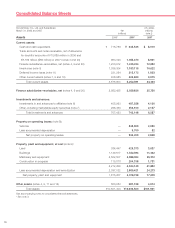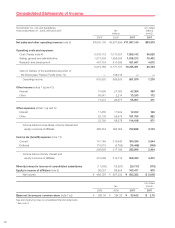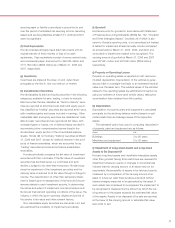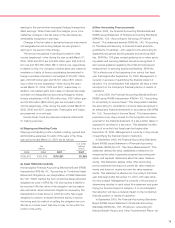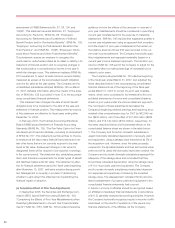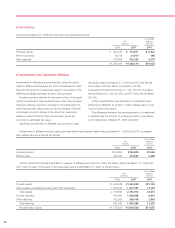Honda 2007 Annual Report Download - page 80
Download and view the complete annual report
Please find page 80 of the 2007 Honda annual report below. You can navigate through the pages in the report by either clicking on the pages listed below, or by using the keyword search tool below to find specific information within the annual report.
78
(m) Income Taxes
Income taxes are accounted for under the asset and liability
method. Deferred tax assets and liabilities are recognized for
the future tax consequences attributable to differences
between the financial statement carrying amounts of existing
assets and liabilities and their respective tax bases and oper-
ating loss and tax credit carryforwards. Deferred tax assets
and liabilities are measured using enacted tax rates expected
to apply to taxable income in the years in which those tem-
porary differences are expected to be recovered or settled.
The effect on deferred tax assets and liabilities of a change in
tax rates is recognized in earnings in the period that includes
the enactment date.
(n) Product-Related Expenses
Advertising and sales promotion costs are expensed as
incurred. Advertising expenses for each of the years in the
three-year period ended March 31, 2007 were ¥246,997 mil-
lion, ¥287,901 million and ¥308,409 million ($2,613 million),
respectively. Provisions for estimated costs related to product
warranty are made at the time the products are sold to cus-
tomers or new warranty programs are initiated. Estimated
warranty expenses are provided based on historical warranty
claim experience with consideration given to the expected
level of future warranty costs as well as current information
on repair costs. Included in warranty expenses accruals are
costs for general warranties on vehicles Honda sells and
product recalls.
(o) Basic Net Income per Common Share
Basic net income per common share has been computed by
dividing net income available to common stockholders by the
weighted average number of common shares outstanding
during each year. The weighted average number of common
shares outstanding for the years ended March 31, 2005,
2006 and 2007 was 1,867,535,957, 1,840,799,671 and
1,824,675,228 respectively. There were no potentially dilutive
shares outstanding during the years ended March 31, 2005,
2006 or 2007.
The Company executed a two-for-one stock split for the
Company’s common stock effective July 1, 2006. All per
share information has been adjusted retroactively for all
periods presented to reflect this stock split.
(p) Foreign Currency Translation
Foreign currency financial statement amounts are translated
into Japanese yen on the basis of the year-end rate for all
assets and liabilities and the weighted average rate for the
year for all income and expense amounts. The resulting
translation adjustments are included in accumulated other
comprehensive income (loss) in the stockholders’ equity
section of the consolidated balance sheets.
Foreign currency receivables and payables are translated
at the applicable current rates on the balance sheet date. All
revenues and expenses associated with foreign currencies
are converted at the rates of exchange prevailing when such
transactions occur. The resulting exchange gains or losses
are reflected in other income (expense) in the consolidated
statements of income.
Foreign currency transaction gains (losses) included in
other income (expenses) - other for each of the years in the
three-year period ended March 31, 2007 are as follows:
U.S. dollars
Yen (millions)
(millions) (note 2)
2005 2006 2007 2007
¥(17,146) ¥(38,880) ¥(48,261) $(409)
(q) Derivative Financial Instruments
Honda has entered into foreign exchange agreements and
interest rate agreements to manage currency and interest
rate exposures. These instruments include foreign currency
forward contracts, currency swap agreements, currency
option contracts and interest rate swap agreements.
Honda recognizes at fair value of all derivative financial
instruments in its consolidated balance sheet.
Honda applies hedge accounting for certain foreign
currency forward contracts related to forecasted foreign cur-
rency transactions between the Company and its subsidiar-
ies. These are designated as cash flow hedges on the date
derivative contracts entered into. The Company has a cur-
rency rate risk management policy documented. In addition,
it documents all relationships between derivative financial
instruments designated as cash flow hedges and the relevant
hedged items to identify the relationship between them. The
Company assesses, both at the hedge’s inception and on an
ongoing basis, whether the derivative financial instruments
designated as cash flow hedge are highly effective to offset
changes in cash flows of hedged items.
When it is determined that a derivative financial instrument
is not highly effective as a cash flow hedge, when the
hedged item matures, is sold or is terminated, or when it is
identified that the forecasted transaction is no longer prob-
able, the Company discontinues hedge accounting. To the
extent derivative financial instruments are designated as cash
flow hedges and have been assessed as being highly effec-
tive, changes in their fair value are recognized in other com-
prehensive income (loss). The amounts are reclassified into




